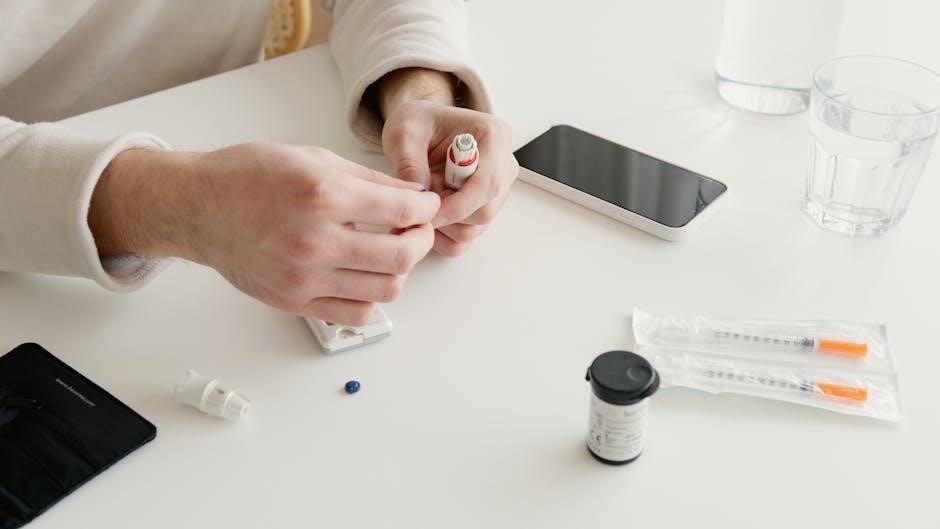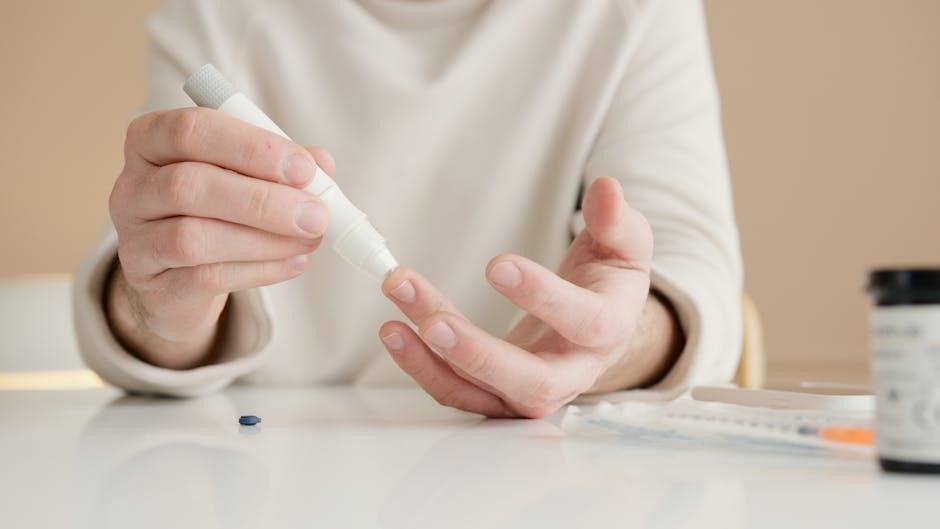A needle stick injury (NSI) is a penetrating wound caused by a needle, posing risks of blood-borne pathogen transmission. Understanding its significance is crucial for healthcare safety protocols;
1.1 Definition and Significance of NSI
A needle stick injury (NSI) is a puncture wound caused by a needle, often occurring in healthcare settings. It poses risks of transmitting blood-borne pathogens like HIV, HBV, and HCV. NSI is significant as it endangers healthcare workers, necessitating immediate protocols to minimize infection risks and ensure prompt treatment, highlighting the importance of prevention and management strategies in occupational safety.
1.2 Importance of NSI Protocol
An NSI protocol is crucial for minimizing risks after a needle stick injury. It ensures immediate actions like wound care and reporting, reducing infection chances. Proper protocols also provide a structured response, including post-exposure prophylaxis (PEP) and testing, safeguarding healthcare workers’ health and preventing long-term consequences. Adherence to these guidelines is vital for maintaining a safe working environment and protecting against blood-borne pathogens effectively.

Causes and Risk Factors of Needle Stick Injuries
Needle stick injuries often result from accidental needle pricks during medical procedures. High-risk occupations include healthcare workers, particularly nurses and surgeons, who frequently handle sharps. Improper needle handling, lack of safety devices, and stressful work environments contribute to the risk. These factors highlight the need for strict protocols to minimize occurrences.
2.1 Common Scenarios Leading to NSI
Needle stick injuries commonly occur during injections, blood draws, or handling sharps. Recapping needles manually and improper disposal of sharps increase risks. High-pressure environments, such as emergency rooms, often lead to distractions, escalating the likelihood of accidents. Additionally, procedures involving multiple needle insertions or difficult patient cases heighten susceptibility. These scenarios underscore the importance of adhering to safety protocols to mitigate risks in healthcare settings.
2.2 High-Risk Occupations and Settings
Healthcare workers, particularly nurses and surgeons, are at high risk of NSI due to frequent needle use. Settings like hospitals, clinics, and laboratories pose increased danger. Procedures involving sharps, such as surgery or blood sampling, further elevate risks. Additionally, emergency rooms and trauma care units, where urgency and high patient volumes prevail, contribute to higher injury rates. Understanding these high-risk environments is crucial for implementing targeted safety measures and reducing exposure incidents.

Immediate Steps After a Needle Stick Injury
Immediate steps after NSI include washing the wound with soap and water, not squeezing it, and reporting the incident promptly for further evaluation and care.
3.1 First Aid and Wound Care
First aid for NSI involves immediate washing of the wound with soap and water to reduce infection risk. Avoid squeezing or scrubbing the area. Use antiseptic solution if available. Pat dry with a clean cloth. Apply a sterile bandage to protect the wound. Do not apply harsh chemicals or cauterize the injury. These steps minimize contamination and prevent infection spread, ensuring proper wound care following exposure.
3.2 Reporting the Incident
Reporting a needle stick injury is crucial for prompt management and prevention of potential infections. Document the incident with details such as the date, time, and circumstances. Notify supervisors and occupational health immediately. Provide information about the source patient, if known, to assess infection risk. This step ensures proper documentation and facilitates further medical evaluation and treatment, adhering to workplace safety protocols and legal requirements for occupational exposures.

Post-Exposure Prophylaxis (PEP)
PEP is a critical intervention to prevent infection after a needle stick injury. It involves administering antiretroviral drugs to reduce the risk of HIV, HBV, or HCV transmission, ideally within hours of exposure, under medical supervision.
4.1 What is PEP?
Post-Exposure Prophylaxis (PEP) is an emergency medication regimen to prevent infection after potential exposure to blood-borne pathogens like HIV, HBV, or HCV. It typically involves antiretroviral drugs for HIV, hepatitis B immune globulin, and/or hepatitis B vaccination. PEP must be initiated promptly, ideally within hours of exposure, to maximize effectiveness. It is a critical component of needle stick injury management, aiming to halt the establishment of infection in the exposed individual.
4.2 Administration and Timeline
PEP should be administered as soon as possible, ideally within hours of exposure, to maximize effectiveness. The regimen typically includes antiretroviral drugs for HIV, hepatitis B immune globulin, and/or hepatitis B vaccination. The treatment duration is usually 28 days, depending on the exposure type and source patient’s infection status. Prompt initiation and adherence to the full course are critical to prevent infection. Monitoring for potential side effects and ensuring completion of the regimen are essential components of PEP administration.

Testing and Follow-Up
Required laboratory tests include blood screening for HIV, HBV, and HCV. Monitoring for infection involves regular check-ups and repeat testing at intervals to ensure clearance and health status.
5.1 Required Laboratory Tests
Following a needle stick injury, laboratory tests are essential to assess exposure risks. Initial tests include HIV antibody, HBV surface antigen, and HCV antibody screenings. Additional tests may involve liver function checks and complete blood counts. These assessments help identify potential infections early. Repeat testing is conducted at intervals (e.g., 6 weeks, 3 months) to monitor seroconversion. Timely results guide further post-exposure prophylaxis (PEP) and ensure appropriate medical intervention, minimizing long-term health risks for the injured individual.
5.2 Monitoring for Infection
After a needle stick injury, monitoring for infection is critical to ensure early detection and treatment. Regular follow-ups, including physical exams and symptom checks, are conducted over 6 months. Signs of infection, such as fever or fatigue, are closely watched. Blood tests are repeated at intervals to detect seroconversion for HIV, HBV, or HCV. Even if initial tests are negative, prolonged monitoring is essential, as infections may develop later. This approach helps prevent long-term health complications and ensures timely intervention if needed.

Prevention Strategies
Preventing NSIs involves using safety syringes with sharps injury protection features and ensuring proper disposal of needles. Protocols like safe handling and disposal reduce risks significantly.
6.1 Engineering Controls
Engineering controls are critical in preventing NSIs, focusing on physical barriers and safer medical devices. Safety syringes with sharps injury protection (SIP) features, as recommended by WHO, reduce accidental punctures. Needleless systems and devices with built-in shielding or retractable needles also minimize risks. Proper disposal methods, such as using puncture-proof containers, further prevent injuries. These measures create a safer environment, reducing reliance on human behavior and enhancing overall protection against sharps injuries in healthcare settings.
6.2 Administrative and Educational Measures
Administrative and educational measures play a vital role in reducing NSIs. Training programs educate healthcare workers on safe practices, proper use of safety devices, and emergency protocols. Policies enforcing the use of personal protective equipment (PPE) and safer medical devices are essential. Regular updates on guidelines, such as those from CDC and WHO, ensure compliance and awareness. These measures complement engineering controls, fostering a culture of safety and accountability to minimize occupational exposures and enhance overall workplace protection.
Psychological Impact and Support
A needle stick injury often causes stress and anxiety, emphasizing the need for counseling and helpline support to address emotional trauma and ensure mental well-being;
7.1 Stress and Anxiety Management
Needle stick injuries often trigger significant stress and anxiety due to the risk of infection. Emotional support is essential to help individuals cope. Counseling services and helpline access are recommended to address psychological trauma. Employers should promote a supportive environment, encouraging open discussions about fears and concerns. Regular follow-ups and clear communication about test results can reduce anxiety. Stress management techniques, such as mindfulness and relaxation exercises, may also be beneficial. Ensuring mental well-being is a critical part of the recovery process.
7.2 Counseling and Support Services
Counseling and support services are vital for individuals affected by needle stick injuries; These services address emotional and psychological needs, providing reassurance and coping strategies. Employers often offer access to mental health professionals and helpline services. Confidential counseling sessions help individuals process their experience and reduce long-term psychological impacts. Support services also connect individuals with resources for stress management and trauma recovery, ensuring comprehensive care beyond immediate medical treatment. These services foster resilience and aid in returning to work confidently.
Effective needle stick injury protocols are essential for reducing risks and ensuring proper management. Prevention, timely intervention, and support systems are crucial for minimizing harm and promoting safety.
8.1 Summary of Key Points
The management of needle stick injuries requires a comprehensive approach, including immediate first aid, reporting, and post-exposure prophylaxis. Prevention strategies, such as using safety syringes and proper sharps disposal, are critical. Regular training and psychological support for affected individuals are essential. Timely testing and follow-up ensure early detection and treatment of potential infections. Adhering to established protocols minimizes risks and promotes a safer environment for healthcare workers. Effective implementation of these measures is vital for reducing the incidence and impact of NSIs.
8.2 Final Thoughts on NSI Management
Effective NSI management requires a holistic approach, combining prevention, immediate care, and long-term support. Prioritizing safety measures, such as using protective equipment and adhering to protocols, is crucial. Timely medical intervention and psychological support ensure better outcomes for affected individuals. Continuous education and policy updates are essential to mitigate risks in healthcare settings. By fostering a culture of safety and awareness, we can reduce the incidence and impact of needle stick injuries, protecting both healthcare workers and patients.